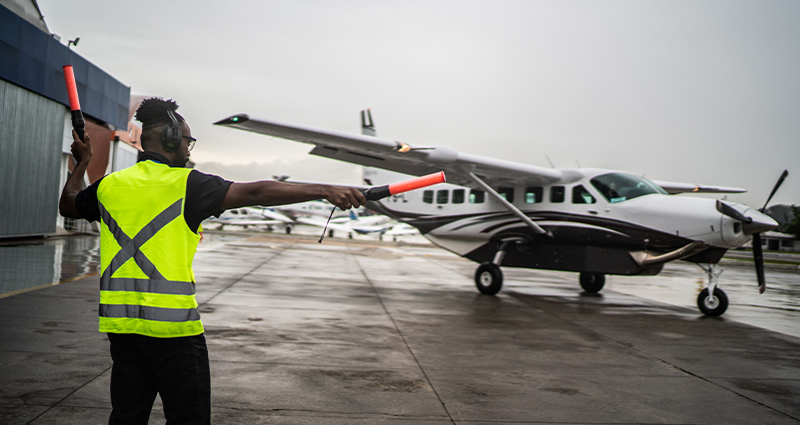The Insidious Nature of the Routine

When routine tasks become familiar and are no longer actively assessed for threats, they often are the first link in an error chain that results in a serious mishap. It is natural for crews to become comfortable with seemingly low-risk tasks, allowing complacency and distractions to permeate their focused attention.
For example, many pilots see the very first phase of flight—preflight to holding short of the runway—as low-risk, even though internal and external distractions are a constant threat. These distractions may be subtle, discreet and gradual.
A Hard (and Expensive) Lesson About Complacency
Recently, a situation resulted in substantial damage to an aircraft, a hard lesson for the crew and a flipped airport vehicle. It was all due to a simple miscommunication between a flight attendant and the pilots over where to arrive, combined with a little bit of pressure to be on time.
During preflight, the pilot-in-command (PIC) left the baggage door of the aircraft open, anticipating the flight attendant would arrive shortly and need to stow their baggage. The crew was under pressure to depart on time to pick up passengers at a nearby airport after a short reposition flight. The preflight was described as “rushed” in the post-incident report.
Shortly after conducting the preflight (leaving the baggage door open), the PIC received word from their company that the flight attendant would not be on board for the repositioning leg and instead would drive to the nearby airport to meet the passengers and board with them.
The crew started the engines less than five minutes later and began the pre-taxi checklist. Meanwhile, ground personnel noticed the open baggage door and drove an ATV to the aircraft. They parked in front of the left wing and waved to the crew, indicating an open door. The PIC left his seat, exited the cockpit and closed the baggage door.
On returning to his seat and resuming the pre-taxi checklist, the PIC noticed the aircraft rolling forward and felt a “bump.” Both crewmembers attempted to apply brake pressure to stop the aircraft, but it continued to roll. The PIC shut both engines down, and at the same time, the second-in-command (SIC) released and reset the parking brake, and the aircraft came to a stop. The left wing struck the parked ATV during the forward roll and caused substantial damage to the aircraft.
The NTSB cited the crew’s failure to verbally follow the before-start checklist, verify the hydraulic system pressure and engage the parking brake before starting the engines, as well as the crew’s failure to see and avoid objects around the aircraft as a probable cause.
The Danger in Distractions
A distraction or threat may not always be as apparent as ground crew running up to your aircraft waving their arms. It can be anything that pulls your attention away from the original task or plan. Distractions are as insidious as a miscommunication with a crewmember or passenger that starts a chain of events, leading to a damaged airplane or worse. Examples of mishaps ranging from pilot deviations on departure to runway incursions can be traced back to distractions on the ramp or during taxi.
When approaching different flight segments, pilots are more attentive during perceived high-risk phases such as takeoff, initial climb-out and approach and landing. Pilots are often more passive during perceived low-risk segments such as preflight and taxi.
Many think, “We’re on the ground, what could possibly go wrong?” Moreover, sterile cockpit policies (policies that prohibit non-essential cockpit communications during critical phases of flight) are designed to reduce distractions but rarely include preflight inspections, flight deck and avionics setup while parked and other critical operations done before starting engines.
By expanding what are considered critical phases of flight to include the tasks done prior to engine start, a higher level of threat and error detection can be maintained.
Common distractions before takeoff include:
- Ramp personnel interrupting the preflight inspection to ask about fueling or catering
- Interruptions during Flight Management System (FMS) programing, flight deck setup or performance planning
- Taxi route changes after the taxi has begun
- Runway or routing changes, especially reassignment of a Standard Instrument Departure (SID) while taxiing
- CAS/MASTER Caution indications
- Ground stops or lengthy release times
Staying Mindful of the Mundane
As pilots, we train for a wide range of threats, malfunctions and emergencies. The first step is always to recognize an unsafe situation is unfolding. This is easily done when a master warning illuminates or a fire bell sounds. It is more difficult to detect an unsafe situation unfolding when it’s a seemingly mundane item, like leaving a baggage door open to accommodate a fellow crew member.
To combat these subtle but impactful hazards, keep in mind that each task is critical to the safety of the flight. By treating all ground activities with the same focus you give critical phases of flight, you may just catch that one loose cowl fastener on preflight, the discontinuity in the FMS or a parking brake not set that will prevent an incident from occurring.
 FlightSafety International
FlightSafety InternationalFlightSafety International is the world’s premier professional aviation training company and supplier of flight simulators, visual systems and displays to commercial, government and military organizations. The company provides training for pilots, technicians, and other aviation professionals from 167 countries and independent territories. FlightSafety operates the world’s largest fleet of advanced full-flight simulators at Learning Centers and training locations in the United States, Canada, France, the United Kingdom and Singapore.
https://flightsafety.com
© 2025 FlightSafety International. All Rights Reserved.
Next ArticleRelated Posts

Part 108: The Next Step in BVLOS Integration and Drone Innovation
As the drone industry awaits the Federal Aviation Administration’s (FAA) forthcoming Part 108 regulations, the landscape of Beyond Visual Line of Sight (BVLOS) operations stands on the brink of transformation. These anticipated rules aim to standardize BVLOS flights, enabling more complex and expansive drone missions across various sectors.

Giving the Hazard Log the Attention It Deserves
Safety risk profile. Hazard log. Hazard risk register. Whatever you call it internally, one thing is clear: It is a fundamental requirement in your safety management system.

